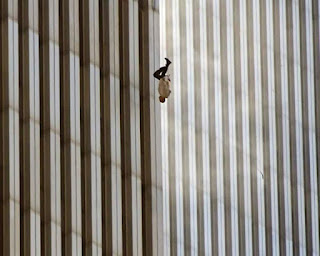Falling Man, 2001: The most widely seen images from 9/11 are of planes and towers, not people. Falling Man is different.
Falling Man, 2001: The most widely seen images from 9/11 are of planes and towers, not people. Falling Man is different.
The photograph was widely criticized after publication in international media on September 12, 2001, with readers labeling the image as "disturbing, cold-blooded, ghoulish, and sadistic". However, in the years following, the photo has gained acclamation.
Now regarded as a masterpiece in photojournalism, it is regarded as one of the greatest and most important pieces of art from the 21st century. A Time Magazine retrospective published in 2016 stated "Falling Man’s identity is still unknown, but he is believed to have been an employee at the Windows on the World restaurant, which sat atop the north tower.
The true power of Falling Man, however, is less about who its subject was and more about what he became: a makeshift Unknown Soldier in an often unknown and uncertain war, suspended forever in history."
Of the 2,606 victims killed inside the Twin Towers and on the ground in New York City during the September 11 attacks, some have estimated that at least 200 people fell to their deaths from the burning towers, while other estimates put the number around 100.
All but three were witnessed falling from the North Tower, where considerably more people were trapped on far fewer floors.
Most of the people who fell from the World Trade Center were jumpers who had no choice but to take their own lives by deliberately leaping to their deaths from hundreds of feet in the air as their only means of escaping the extreme heat, smoke and flames, although a much smaller percentage of the deaths were accidents caused by people losing their grip or being knocked off balance near window ledges. Officials could not recover or identify the bodies of those forced out of the towers prior to their collapse.
The New York City medical examiner's office said it does not classify them as "jumpers," explaining that a 'jumper' is defined as someone who "goes to the office in the morning knowing that they will commit suicide," adding that the victims who fell from the towers did not want to die but "were forced out by the smoke and flames or blown out."
The morning of September 11, Richard Drew was on assignment for the Associated Press, photographing a maternity fashion show in Bryant Park. Alerted by his editor to the attacks, Drew took the subway to the Chambers Street subway station, near the World Trade Center site. He took the falling man image while at the corner of West and Vesey Street from a low angle.
He took eight photographs in sequence, after realizing that a series of loud cracking sounds was not that of falling concrete, but rather people hitting the ground. He took between ten and twelve different sequences of images of people jumping from the tower, before having to leave the site due to the South Tower's collapse.
The man fell from the south side of the North Tower's west face. Thus, the left half of the backdrop features the North Tower while the South Tower is visible on the right. The photograph gives the impression that the man is falling straight down; however, a series of photographs taken of his fall shows him to be tumbling through the air.











Comments
Post a Comment